
A waist cincher (sometimes referred to as a waspie) is a belt worn around the waist to make the wearer's waist physically smaller, or to create the illusion of being smaller.

A waist cincher (sometimes referred to as a waspie) is a belt worn around the waist to make the wearer's waist physically smaller, or to create the illusion of being smaller.
Waist cinchers and waspies from the 1980s are a type of wide, laced belts with elastic fabric and soft plastic stiffeners. [1]
The ribbon corset is made of pieces of ribbon, as opposed to fabric. In 1901, a simple pattern of silk ribbon, two bones, and a busk was available, allowing women to construct their own ribbon corsets. [2]
A pseudo-ribbon corset looks like a ribbon corset but is made from cut cloth instead of ribbons. The outside seam of the cut cloth is sewn fine, while the tight inside seam is sewn plain and curved. [3]
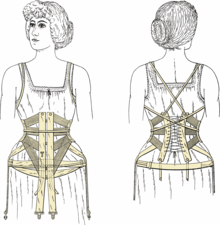
Short corsets have been used as light corsets for sleeping or light corsets that may be used next to the skin or over clothing. There are also elastic girdle belt styles that have been used on the inside of shape-enhancing garments, on their own as shapeware (items designed to be worn under and not be visible that help smooth, shape the figure to improve look of the wearer.)
There are a number of modern fashions that resemble the styles of the past, from wide elastic belts to actual modern corsets. The trend and styling of these belts moves rather quickly but the basic design remains the same: elastic in the back with some sort of closure in the front meant to define the waist or accent an outfit.
The more traditional boned styles of corset still exist in modern corset making. The corset styles that best represent this classic waist cincher fashion are 'Spanish belts' that can also come with elastic in the back, and act very much like the more modern belt-like styles.
More classic corset styles from which lighter corsets have adopted their fit and function are still available. They work basically the same way as the elastic and lighter styles, accenting an outfit or defining a waist, but they also offer better back support. Some serve as a fashionable alternative to certain kinds of medical back braces; these styles include the 'French underbust' and the 'long line underbust'.
Dior's "New Look" brought the waist cincher to popularity around 1947. In his autobiography, Dior wrote: "I designed clothes for flower-like women, with rounded shoulders, full feminine busts, and hand-span waists above enormous spreading skirts". [4]
The hand-span waists so beloved by Dior were achieved by foundation garments, of which the most popular was the waist cincher. Called the "waspie" or "guepiere", it became the quintessential undergarment of the "New Look". Boned and back-laced, it differed from the Victorian corset of decades past primarily in its length, usually only 6 to 7 inches. Fashion magazines of the time stressed that it was "super-light weight" and contained "feather boning". Such garments were worn tightly cinched at the waist, usually over a girdle. The combination was described by Anne Fogarty, an American dress designer who popularized the "New Look" in the US: "To maintain your figure at its flattering best, depend on foundation garments to control and distribute; a cinch or tight belt to restrain." [5]
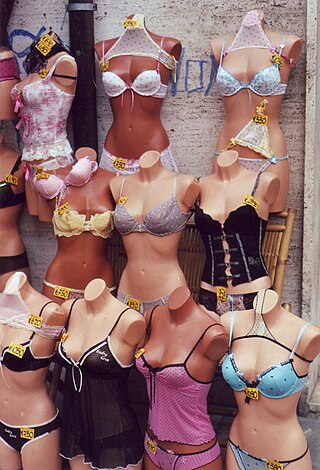
Lingerie is a category of primarily women's clothing including undergarments, sleepwear, and lightweight robes. The choice of the word is often motivated by an intention to imply that the garments are alluring, fashionable, or both. In a 2015 US survey, 75% of women reported having worn "sexy lingerie" in their lifetime.
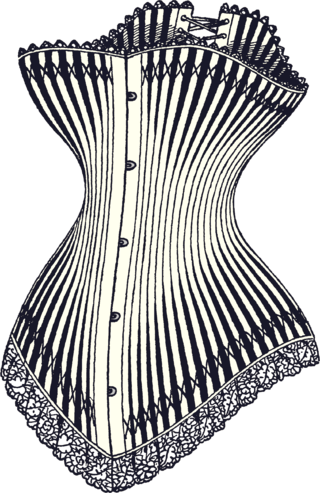
A corset is a support undergarment worn to hold and train the torso into the desired shape and posture. They are traditionally constructed out of fabric with boning made of whalebone or steel, a stiff panel in the front called a busk which holds the torso rigidly upright, and some form of lacing which allows the garment to be tightened. Corsets were an essential undergarment in European women's fashion from the 17th century to the early 20th century. In the 17th and 18th centuries they were commonly known as "stays" and had a more conical shape. This later evolved into the curvaceous 19th century form which is commonly associated with the corset today. By the beginning of the 20th century, shifting gender roles and the onsets of World War I and II led the corset to be largely discarded by mainstream fashion.
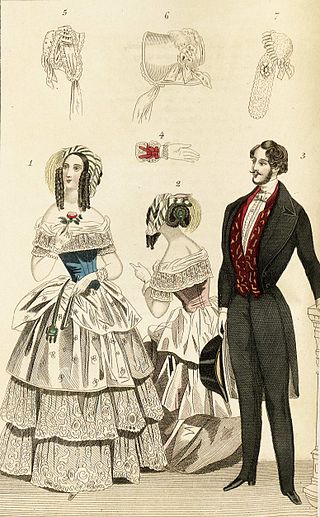
Victorian fashion consists of the various fashions and trends in British culture that emerged and developed in the United Kingdom and the British Empire throughout the Victorian era, roughly from the 1830s through the 1890s. The period saw many changes in fashion, including changes in styles, fashion technology and the methods of distribution. Various movement in architecture, literature, and the decorative and visual arts as well as a changing perception of gender roles also influenced fashion.
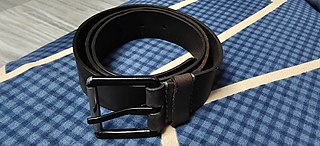
A belt is a flexible band or strap, typically made of leather, plastic, or heavy cloth, worn around the natural waist or near it. The ends of a belt are free; and a buckle forms the belt into a loop by securing one end to another part of the belt, at or near the other end. Often, the resulting loop is smaller than the hips. Belts come in many lengths because of the variety in waist sizes, and most belts can be adjusted at the buckle to suit the wearer's waist.

Tightlacing is the practice of wearing a tightly laced corset. It is done to achieve cosmetic modifications to the figure and posture or to experience the sensation of bodily restriction. The process was highly controversial and saw much backlash both from medical doctors and dress reformers, and was often seen as a result of excessive vanity by the general public.

A crinoline is a stiff or structured petticoat designed to hold out a skirt, popular at various times since the mid-19th century. Originally, crinoline described a stiff fabric made of horsehair ("crin") and cotton or linen which was used to make underskirts and as a dress lining. The term crin or crinoline continues to be applied to a nylon stiffening tape used for interfacing and lining hemlines in the 21st century.
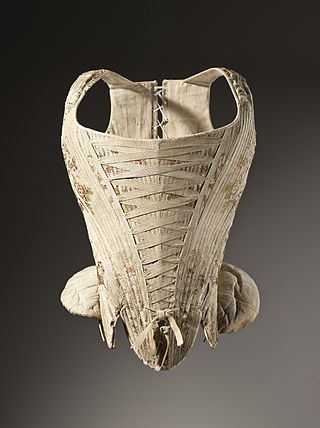
The corset is a supportive undergarment for women, dating, in Europe, back several centuries, evolving as fashion trends have changed and being known, depending on era and geography, as a pair of bodies, stays and corsets. The appearance of the garment represented a change from people wearing clothes to fit their bodies to changing the shape of their bodies to support and fit their fashionable clothing.
Boxer briefs are a hybrid type of men's undergarment which are long in the leg, similar to boxer shorts, but tight-fitting like briefs. They emerged as a style in the 1990s and are commonly worn for sports and as every-day underwear.

1860s fashion in European and European-influenced countries is characterized by extremely full-skirted women's fashions relying on crinolines and hoops and the emergence of "alternative fashions" under the influence of the Artistic Dress movement.

A babydoll is a short, sleeveless, loose-fitting nightgown or negligee, intended as nightwear for women. It sometimes has formed cups called a bralette for cleavage with an attached, loose-fitting skirt falling in length usually between the belly button and upper thigh. The garment is often trimmed with lace, ruffles, appliques, marabou, bows, and ribbons, optionally with spaghetti straps. Sometimes it is made of sheer or translucent fabric such as nylon or chiffon or silk.

In women's clothing, a corselet or corselette is a type of foundation garment, sharing elements of both bras and girdles. It extends from straps over the shoulders down the torso, and stops around the top of the legs. It may incorporate lace in front or in back. As an undergarment, a corselet can be open-style or panty-style.

A foundation garment is an undergarment designed to impermanently alter the wearer's body shape, to achieve what some view as a more fashionable figure. The function of a foundation garment is not to enhance a bodily feature but to make it look more presentable.

1850s fashion in Western and Western-influenced clothing is characterized by an increase in the width of women's skirts supported by crinolines or hoops, the mass production of sewing machines, and the beginnings of dress reform. Masculine styles began to originate more in London, while female fashions originated almost exclusively in Paris.

Fashion in the years 1750–1775 in European countries and the colonial Americas was characterised by greater abundance, elaboration and intricacy in clothing designs, loved by the Rococo artistic trends of the period. The French and English styles of fashion were very different from one another. French style was defined by elaborate court dress, colourful and rich in decoration, worn by such iconic fashion figures as Marie Antoinette.

A waistband is a strip of material that is either elastic or some other confining fabric that encircles the waist, usually as a component of clothing such as skirts, trousers, shorts, swimsuits, and undergarments.

The history of bras is closely tied to the social status of women, the evolution of fashion, and shifting views of the female body over time.
The bliaut or bliaud is an overgarment that was worn by both sexes from the eleventh to the thirteenth century in Western Europe, featuring voluminous skirts and horizontal puckering or pleating across a snugly fitted under bust abdomen. The sleeves are the most immediately notable difference when comparing the bliaut to other female outer clothing of the Middle Ages. They fit closely from the shoulder to approximately the elbow, and then widen from the elbow to drape to floor- or nearly floor-length. This garment's usage appears to be geographically limited to areas of French influence, with some works depicting the garment or the garment in transition as far away as Rome and modern Germany.

In fashion, a sheath dress is a fitted, straight cut dress, often nipped at the waistline with no waist seam. When constructing the dress, the bodice and skirt are joined together by combining the skirt darts into one dart: this aligns the skirt darts with the bodice waist dart. The dress emphasizes the waist as its skirt portion is fitted. While the sheath dress can come in many patterns and lengths, it often is worn with short sleeves and reaches knee length.

Underwear, underclothing, or undergarments are items of clothing worn beneath outer clothes, usually in direct contact with the skin, although they may comprise more than a single layer. They serve to keep outer clothing from being soiled or damaged by bodily excretions, to lessen the friction of outerwear against the skin, to shape the body, and to provide concealment or support for parts of it. In cold weather, long underwear is sometimes worn to provide additional warmth. Special types of undergarments have religious significance. Some items of clothing are designed as undergarments, while others, such as T-shirts and certain types of shorts, are appropriate both as underwear and outerwear. If made of suitable material or textile, some underwear can serve as nightwear or swimwear, and some undergarments are intended for sexual attraction or visual appeal.

A girdle is a form-fitting foundation garment that encircles the lower torso, extending below the hips, and worn often to shape or for support. It may be worn for aesthetic or medical reasons. In sports or medical treatment, a girdle may be worn as a compression garment. This form of women's foundation replaced the corset in popularity, and was in turn to a larger extent surpassed by pantyhose in the 1960s.